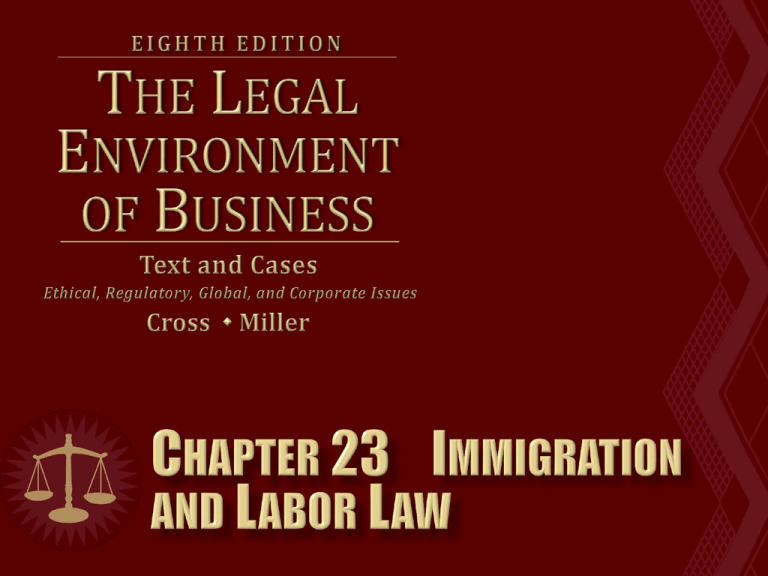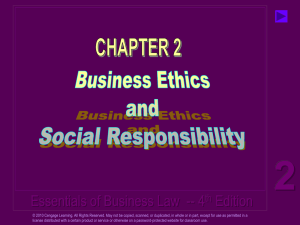
Immigration
Reform and
Control Act: makes it illegal to
hire, recruit, or refer for a fee,
someone not authorized to work
in the U.S.
I-9
Verification: for new hires.
Enforcement: by I.C.E.
Penalties.
© 2012 Cengage Learning. All Rights Reserved. May not be copied, scanned, or duplicated, in whole or in part, except for use as
permitted in a license distributed with a certain product or service or otherwise on a password-protected website for classroom use.
2
Immigration
Reform and
Control Act (cont’d):
Criminal
Actions: ICE can seek
criminal punishments.
CASE 23.1 Trollinger v. Tyson
Foods, Inc. (2007). Why did the
court dismiss the RICO claim?
Penalties for employers.
Discrimination.
© 2012 Cengage Learning. All Rights Reserved. May not be copied, scanned, or duplicated, in whole or in part, except for use as
permitted in a license distributed with a certain product or service or otherwise on a password-protected website for classroom use.
3
The
Immigration Act places
caps on the number of visas that
can be issued to immigrants
every year.
I-551 Alien Registration Receipts.
The H-1B Visa Program.
Labor Certification.
H-2, O, L, and E Visas.
© 2012 Cengage Learning. All Rights Reserved. May not be copied, scanned, or duplicated, in whole or in part, except for use as
permitted in a license distributed with a certain product or service or otherwise on a password-protected website for classroom use.
4
Norris-LaGuardia
Act: protects
peaceful strikes by limiting the
injunction powers of federal
courts.
National
Labor Relations Act:
establishes the right of workers to
strike and engage in collective
bargaining. Established NLRB.
© 2012 Cengage Learning. All Rights Reserved. May not be copied, scanned, or duplicated, in whole or in part, except for use as
permitted in a license distributed with a certain product or service or otherwise on a password-protected website for classroom use.
5
Labor
Management Relations
Act: prohibits certain unfair
union practices such as closed
shops. Allowed individual states
to pass right-to-work laws.
Labor-Management Reporting
and Disclosure Act: hot cargoagreements, secondary boycotts.
© 2012 Cengage Learning. All Rights Reserved. May not be copied, scanned, or duplicated, in whole or in part, except for use as
permitted in a license distributed with a certain product or service or otherwise on a password-protected website for classroom use.
6
Preliminary Organizing.
Workers sign authorization cards.
Cards can justify an election.
Appropriate Bargaining Unit.
Mutuality of Interest among all
represented workers.
Job Similarity.
Nonmanagement Employees.
© 2012 Cengage Learning. All Rights Reserved. May not be copied, scanned, or duplicated, in whole or in part, except for use as
permitted in a license distributed with a certain product or service or otherwise on a password-protected website for classroom use.
7
Union Election Campaigns.
An election can be held only if
it
can be shown that at least 30%
of the workers will be
represented.
Key Restraint on management
is nondiscrimination rule
(cannot selectively prohibit
union solicitation).
© 2012 Cengage Learning. All Rights Reserved. May not be copied, scanned, or duplicated, in whole or in part, except for use as
permitted in a license distributed with a certain product or service or otherwise on a password-protected website for classroom use.
8
Management
Campaigns.
Election
NLRB
regulates the rights and
obligations of employers and
workers in the election process.
Each side can pursue their
objectives, but cannot interfere,
beyond certain limits, in the
other’s activities.
© 2012 Cengage Learning. All Rights Reserved. May not be copied, scanned, or duplicated, in whole or in part, except for use as
permitted in a license distributed with a certain product or service or otherwise on a password-protected website for classroom use.
9
Case 23.2 Local Joint Executive
Board of Las Vegas v. NLRB
(2008). Were the activities of Ms.
Sapien and Ms. Briand ‘illegal
surveillance’ that violated the
National Labor Relations Act?
© 2012 Cengage Learning. All Rights Reserved. May not be copied, scanned, or duplicated, in whole or in part, except for use as
permitted in a license distributed with a certain product or service or otherwise on a password-protected website for classroom use.
10
Collective
bargaining is the
process by which management
and labor negotiate the terms
and conditions of
employment.
© 2012 Cengage Learning. All Rights Reserved. May not be copied, scanned, or duplicated, in whole or in part, except for use as
permitted in a license distributed with a certain product or service or otherwise on a password-protected website for classroom use.
11
The
NLRB will certify an
exclusive bargaining agent for
labor.
Both labor and management
must bargain in good faith,
but the law does not require
that they reach an agreement.
© 2012 Cengage Learning. All Rights Reserved. May not be copied, scanned, or duplicated, in whole or in part, except for use as
permitted in a license distributed with a certain product or service or otherwise on a password-protected website for classroom use.
12
Terms
and Conditions of
Employment:
Pay, Safety conditions, Insurance,
Pensions.
Closing or Relocating a Plant:
Severance Pay.
Management must bargain over the
economic consequences of moving.
© 2012 Cengage Learning. All Rights Reserved. May not be copied, scanned, or duplicated, in whole or in part, except for use as
permitted in a license distributed with a certain product or service or otherwise on a password-protected website for classroom use.
13
Party’s
actions show good (or
bad) faith.
Examples of bad faith:
Engaging in a campaign among
workers to undermine the union.
Constantly shifting positions on
disputed contract terms.
Sending bargainers who lack authority
to commit the company to a contract.
© 2012 Cengage Learning. All Rights Reserved. May not be copied, scanned, or duplicated, in whole or in part, except for use as
permitted in a license distributed with a certain product or service or otherwise on a password-protected website for classroom use.
14
There
are two forms of strikes:
Economic
Strikes.
These are strikes over wages.
Workers can be replaced by
permanent replacements.
Unfair
Labor Practice Strikes.
Alleging the employer has
committed an unfair labor practice.
© 2012 Cengage Learning. All Rights Reserved. May not be copied, scanned, or duplicated, in whole or in part, except for use as
permitted in a license distributed with a certain product or service or otherwise on a password-protected website for classroom use.
15
Secondary
Boycotts.
Common Situs Picketing.
Hot-Cargo Agreements.
Wildcat Strikes.
Strikes that Threaten National
Health or Safety.
Strikes that Contravene NoStrike Clauses.
© 2012 Cengage Learning. All Rights Reserved. May not be copied, scanned, or duplicated, in whole or in part, except for use as
permitted in a license distributed with a certain product or service or otherwise on a password-protected website for classroom use.
16
Generally,
an employer has the
right to permanent
replacements (striking workers
are not guaranteed a job).
But
if the employer has not hired
replacements, then it must rehire
the strikers to replace open
positions.
© 2012 Cengage Learning. All Rights Reserved. May not be copied, scanned, or duplicated, in whole or in part, except for use as
permitted in a license distributed with a certain product or service or otherwise on a password-protected website for classroom use.
17
Occurs
when the employer
shuts down to prevent
employees from working.
When an employer believes a
strike is imminent.
Lockouts may be a legal
employer response.
© 2012 Cengage Learning. All Rights Reserved. May not be copied, scanned, or duplicated, in whole or in part, except for use as
permitted in a license distributed with a certain product or service or otherwise on a password-protected website for classroom use.
18
Employer’s Refusal to Recognize
Union and Negotiate.
Presumption of Employee Support.
Questions of Majority Support.
Employer’s Interference in Union
Activities.
No threats, or even asking employees
about their views.
© 2012 Cengage Learning. All Rights Reserved. May not be copied, scanned, or duplicated, in whole or in part, except for use as
permitted in a license distributed with a certain product or service or otherwise on a password-protected website for classroom use.
19
Employer’s
Domination of
Union.
Employer’s Discrimination
Against Union Employees.
Union’s Unfair Labor Practices.
Coercion.
Discrimination.
Other Unfair Practices.
© 2012 Cengage Learning. All Rights Reserved. May not be copied, scanned, or duplicated, in whole or in part, except for use as
permitted in a license distributed with a certain product or service or otherwise on a password-protected website for classroom use.
20
Concerted
Activity.
CASE 23.3 NRLB v. Hotel
Employees and Restaurant
Employees International Union
Local 26, AFL-CIO (2006). Do
you agree with the court that
Johnson was a “pest”?
Safety.
© 2012 Cengage Learning. All Rights Reserved. May not be copied, scanned, or duplicated, in whole or in part, except for use as
permitted in a license distributed with a certain product or service or otherwise on a password-protected website for classroom use.
21







